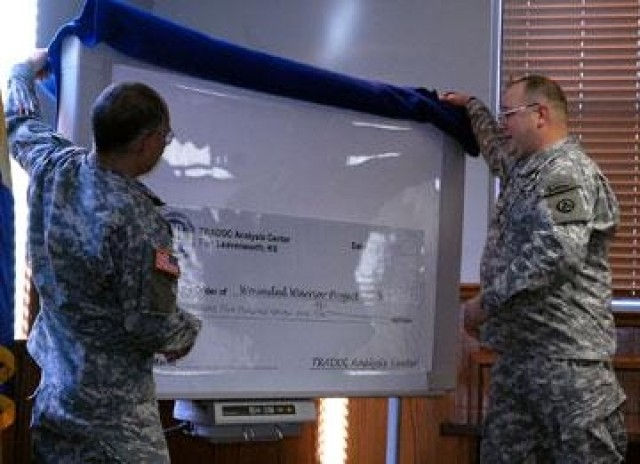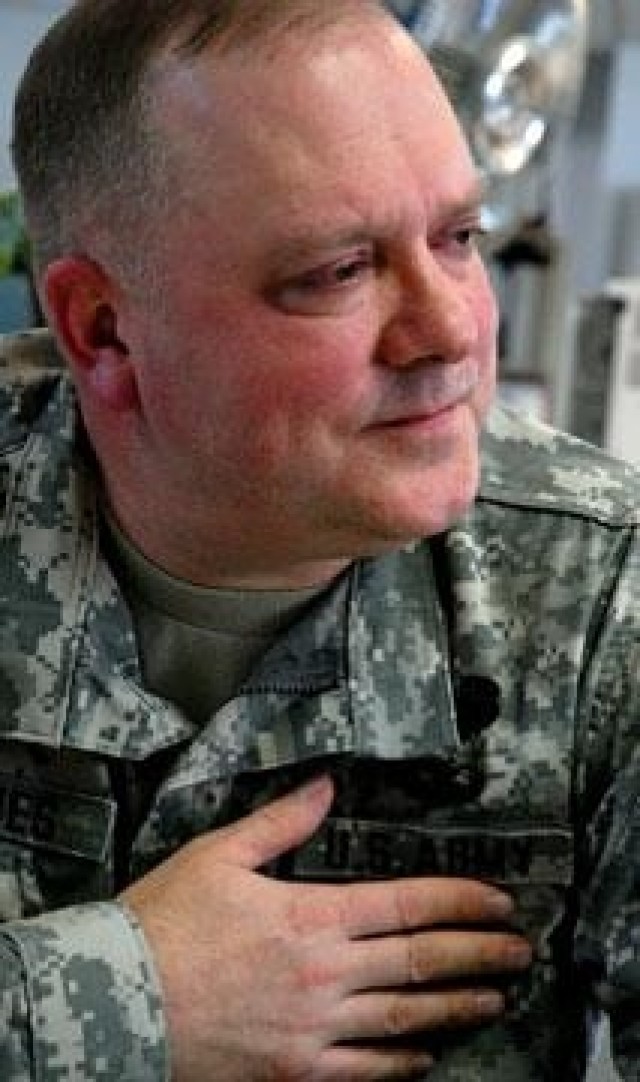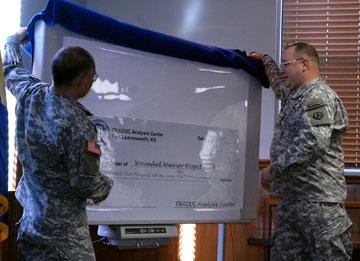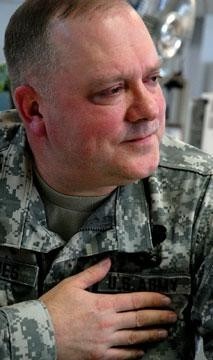The Wounded Warrior Project is $5,007.93 richer, thanks to Fort Leavenworth's TRADOC Analysis Center.
During a ceremony Feb. 28 at TRAC Headquarters in McNair Hall, Ron Magee, director of TRAC-Fort Leavenworth, announced the results of the fund-raiser.
The WWP provides programs and services designed to ease the burdens of wounded Soldiers and their families, aids in the recovery process and helps in the transitions back to civilian life.
"Wounded Warrior Program lets them know that they're not forgotten, that they're cherished and that their service and suffering is recognized and that we're here to help along the way over some of the rough spots," said Lt. Col. John Hughes, TRAC operations research analyst.
TRAC is currently celebrating its 20th anniversary. During his remarks, Magee said he wanted this quarter's fund-raiser at TRAC-Fort Leavenworth to relate directly to the anniversary theme: "Two Decades of Analysis Serving Soldiers."
The result of that desire was "Money Wars for Warriors," a fund-raiser that benefited the WWP.
"The Wounded Warrior Project was founded on the principle that veterans are our nation's greatest citizens," Magee said. "The WWP seeks to assist those men and women of our armed forces who have been severely injured during conflicts in Iraq, Afghanistan and other locations around the world."
The fundraising began on Feb. 12 and was originally scheduled to run through Feb. 23, but was extended to Feb. 28.
Six TRAC directorates participated in the fund-raising "competition." The rules of the fund-raiser, Magee said, were simple: contribute folding money or checks to your organization's pool and get positive credit for it. Contribute coins to another group's pool and they get negative credit for the contribution.
More than $400 in coins was deposited in the fund-raiser, Magee said.
The directorate with the highest difference won the friendly competition. The Scenarios and Wargaming Directorate yielded the highest difference, making it the winner of the inter-office competition. But the real winner was the Wounded Warrior Project, which will receive a check for $5,007.93.
Hughes accepted the check on behalf of the WWP. He said that the Department of Veterans Affairs plays a significant and important role in the recovery process, but they can't do it all.
"There are regrettable holes in the process there, and this program helps supplement that a little bit," Hughes said.
Hughes knows how difficult the road to recovery can be. The Reserve Soldier was injured in Iraq in the fall of 2005 when the armored humvee he was riding in swerved to avoid an improvised explosive device in the road. The vehicle crashed into a concrete median, leaving Hughes with injuries to his neck and shoulder. Rather than leave his team, Hughes stayed in Iraq until August 2006, battling through his injuries before being medevaced to Walter Reed Army Medical Center
Hughes stayed there for six weeks and had a three-and-a-half-inch titanium plate and six screws inserted into his neck.
He was sent home through program called Community Based Health Care Organization, a part of the WWP that allows Reserve and National Guard Soldiers to stay on active duty and working in military capacity during their rehabilitation.
The program's function is not solely about rehabilitation - it's also about compassion. Hughes describes the WWP as a friend in the Soldiers' corner.
"And I'll tell you what, we have a lot of Soldiers that need a friend," Hughes said.
TRAC set a goal of $3,000 for the fund-raiser, or roughly $20 per person participating.
As of Feb. 26, two days before the end of the fund-raiser, Magee said there was approximately $2,200 in contributions.
"So I was pretty sure we were going to make the $3,000 goal, because I knew a lot of people were sitting on money," Magee said. "As of this morning (Feb. 28), there was a lot of activity going on."
The fund-raiser doubled as a friendly competition between departments. One department lined their jar with fake, printed money and blew up balloon inside of the jar so there was no room for rival departments to deposit coins.
"Somebody was complaining that it was unfair, and I said, 'Remember what this is called: Money Wars. There are no rules,'" Magee said.
The check presented during the ceremony stated that the donation would be for $4,907.93. At the ceremony, Magee announced that he and Mike Bauman, director of TRAC, would each add $50 to the pot, pushing the total donation over the $5,000 mark.
"Although these brave Soldiers still face great challenges during their recovery, with the assistance of the Wounded Warrior Project and the help of grateful citizens like you, they will find the opportunities to move on and lead successful and productive lives," Magee said. "With a little help from their friends, the American Soldier can overcome any obstacle."
The final tally will earn TRAC-Fort Leavenworth acknowledgement on the WWP Web site as a corporate sponsor.




Social Sharing